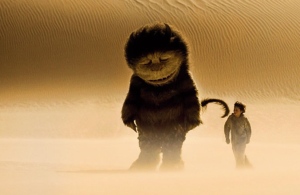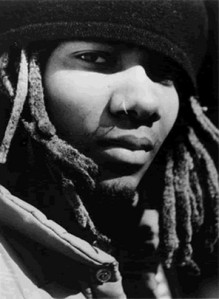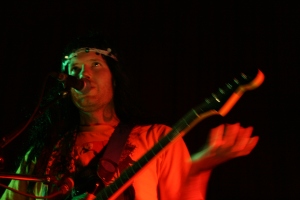
by Miné Salkin | Nov 12, 2009 | film stripped
Children of divorce, loneliness and other magical things
It might be a children’s book, but this is no film for children. I walked into the movie theatre thinking it would make me feel like a child again, but instead I was presented with a familiar vision of childhood divorce, neglect and naivety, without the Freudian psychobabble.
Inspired by Maurice Sendak’s quintessential book, Where The Wild Things Are reminds us of what it’s like to be a lonely, confused albeit imaginative child. Through ten years in the making, the book’s ten sentences drawn from the alter-egos of innovative director Spike Jonze haven’t lead us to naught.

It’s been a while since Jonze showed us the dysfunction and authenticity-grabbing tendencies of the human mind, but Where The Wild Things Are shows off his greatest talent: it’s a convincing delivery of a more tender childhood experience sure to make most grown-ups weep. Like in Being John Malkovich, it’s a portal into the quirky mind and suggestive consciousness of the nine-year-old Max (Max Records), the universal only child, lover of forts and make-believe.
Where’s your daddy?
I read this book to death when I was a child. Most people under fifty have held the beloved story in their hands, heads and hearts. Max’s cheeky mischief leads his mother to banish him to his room, a familiar punishment we’ve all had. If you were an only child like Max and I, you’d have to come up with a way to entertain yourself. You’d never stray too far from home though, away from your mother’s blanketing love and the hot dinner waiting for you.
My parents separated in 1992 during the second highest peak in divorce records during the 20th century. It was more or less a statistical inevitability that it would be my family, aside from the fact that my parents didn’t get along anymore. I remember being whisked away by my mother. I didn’t rebel in the ordinary ways, by getting in trouble at school or acting out at home. Instead, I became the laziest eight-year-old child in the world. It was impossible to rouse me from my room or the little reading forts I made out of blankets in the den. Those covers blinded me from an outside world I didn’t understand, and helped muffle out the loud, operatic movements of my parents’ feuding. I don’t remember playing outside with many children, or even seeing the sky very often. That book was my medicine for loneliness.
Max is like that too. Who is this stranger kissing my mom in the living room? The rage and sense of betrayal carry through cinematically, intimately as Max peers cautiously over the door frame, shouldering the curiosity mingled with confusion. Like a lot of children of divorce, I saw very similar things, but didn’t understand them. Back into the reading fort I went.
A little bit of loneliness is good
When Judith (Catherine O’Hara) asks Max what the cure for loneliness is, his reply is both beautifully and simple, that “a little loneliness is good.”
The Jonzeian vision of this kind of childhood is powerful, because he side-steps the complexity of broken family life by diverting us to the realm of endless imagination. There’s a sadness and beauty in the way Max’s loneliness makes its way into his imagination. He’s in a place we’ve all been to, where your greatest defence was being bigger than anyone around you. After all, what greater fear was there than getting gobbled up by a monster?
Freud and other monsters
When Sendak’s book was published in 1964, a dumpster bin-sized amount of literature spewed out, upchucking explanations for the monsters as oversized, morality play characters, each representing a basic human emotion. Monster Carol (James Gandolfini) could easily be read as a transvestite with an insatiable sexual hunger, hence his voracious appetite for past kings. The asexuality of these creatures could be a Freudian buffet of psychoanalytic opinion. Enough is enough.
Jonze has no patience for this either, and the film manages to bypass the usual jargon of theory. He’s not showing us anything about children because we see them traumatized by the actions of their desperately lonely parents, but rather, the states of play Max delves into.
In the end, this film wasn’t so much about wanting to reconstruct the idea of childhood. Some Freudian theories might explain that as the crux of the book, as some digestible symbol for the fine line between fear, comfort and some deep-seated desire to gobble up your own mother. In reality, you just wanted her to pay more attention to you.
Check out the trailer. It should warm your heart.
[youtube=http://www.youtube.com/watch?v=HS0h9RaP9cw]

by Miné Salkin | Nov 10, 2009 | interviews
spirituality is just a different bandwidth

Paul D. Miller. Academic and musician in a digital world
Radiohead. George Bush. Chinese lyrics. A complex narrative of the current economic chaos without getting boring.
DJ Spooky, a.k.a. Paul D. Miller, has always been a bit of a wild card. Aside from being the creator of illbient sound — an offshoot of hip-hop heavy electronic music that uses dark themes and dissonance — he’s a noted writer on digital music culture in the academic world. His latest album the Secret Song, is no stranger to this notion of shifts in culture in relation to the fine art of sampling. Using a myriad of influences from the literary to the real, Miller weaves together a fine piece of intelligently crafted atmospheric music without getting too cerebral. Blending sounds from ATM machines, to other familiar dub and hip-hop riffs and rock legends like Sonic Youth, Miller articulates current social thoughts on commercialism, materialism and other human obsessions.
Tell me a little bit about Secret Song. Did you try anything new with it, or take any risks?
There’s so much that we don’t really think about – how we wake up and put on clothes made by workers in Indonesia, China, The Phillipines, or the way our computers are made from small fragments of labor — computer chips are made from precious metals mined in strange spots all over the world, the metals used for soldering the motherboards of your hard drive together comes from all over the place, the metal “coltan” that comes from mines in Congo that are in the middle of awar zone, the way bits and pieces are assembled from all over the world into one device someplace in a factory in China. That kind of thing fascinates me. It’s just sampling “materials” instead of sounds, and I wanted to make an album that reflected that kind of thing.
What was it like working with Sonic Youth’s Thurston Moore? What kind of synergy is created when experimental rock collaborates with sounds in electronic music? Think you’ll do this again?
Thurston is an old friend, and I’m a fan of what he’s been up to with Sonic Youth. We’ve done concerts and projects together before, so this is just an extension of the vibe. There’s art rock, so now I do “art hip-hop” — it’s that simple.
Your books weigh heavily and are strongly regarded in the academic community. How do you balance the academic with an artistic life?
Basic vibe: I’m into IDEAS. Music and art, literature and digital media; whatever drives this kind of creative process. At the end of the day, it’s all about ideas. I think that concept — ideas — is the most elusive quality of 21st century life. You have one idea, and you do a google search and you realize that there’s 20,000 other people with the same motives and same drive. What makes you different? That’s something I’m thinking about a lot these days. We’ve moved so far into mass production of experiences; copies, copies, copies!!! That we’ve somehow lost the thread of how we got into this 21st century headspace of the “net” as a reference point for all experience. As an artist, I think its cool. But hey, I’m just creating material all day, every day, so my whole take on this kind of thing is that it’s all about making everything connect. Sound, image, literature, etc. Nothing is out side the framework of digital media at this point. Including “spirituality” — it’s just a different bandwidth.
What do you hope to say about digital culture with Secret Song?
Music is what connects so many thing. It’s deeper than language, more flexible than painting or sculpture, and more elusive than literature. I wanted to do something that would shine a light on this kind of 21st century strangeness of being able to hear anything anywhere, and what that means for creativity. I guess you could say I’m just looking at the post playlist mentality.
You sample failed ATM transactions in the album, is the global economic downturn a big theme in the Secret Song?
The “Global Financial Crisis” is what the album is all about. There’s a trickster scenario going on with the idea that music made of samples can really speak to the fragments of the ponzi scheme that is modern financial life. I’m inspired by writers like Ben Elton with his novel Crisis or J.G. Ballard’s Super-Cannes, stuff like that, but when you really look at how our modern economy works, nobody really knows what makes it all tick.
Remix music gets a lot of flack from copyright law. What do you think it says about human creativity when a whole music culture justifies itself by creating something new by recycling previously existing ideas? Is this a digital renaissance, a paradigm shift, zeitgeist or other artists getting ripped off?
Everything is sampleing: we borrow words, we stress connections and quotations in everyday life, we exchange information at every level by citing facts. It’s all sampling. Copyright law is written for a world of physical objects, and we’re moving into a realm where control of software and how it unfolds, whether you’re Google or Danger Mouse, will make or break the way your bottom line rises or falls. I love the complexity of it all. I wake up every morning and think about how wild it is that I live in the 21st century and the whole planet can relate news and information and music and style at the click of a mouse. This is just the beginning, and copyright law will be sidelined more and more as countries like China, India, Brazil and others come into this mix who are less invested in the normal American/European model of copyright protection.
Now that music is digital, do you think it detracts from the music in any way?
Too many people are listening to frequencies that are missing. Most people experience music these days through their data player, and that means they are basically hearing a really compressed file. Which is crazy! When you think about how complex vinyl was, it’s pretty intense that we’re actually moving into a digital realm where we’re still trying to recreate the signal to noise ratio of audio fidelity that our parents took for granted. But, at the other end of the spectrum, a lot of really high end digital media can be BETTER sounding than anything that was recorded in the past. It’s eerie to see Miles Davis sessions put into super high quality software patches (drums, horn, bass line separated and put into multiple file formats where anyone can take that material and sound just as good). But again, I can only say: this is the beginning, and the Secret Song is just a mirror held up to a society that has been uprooted by the very technologies we use to hold everyday life together. Dig?
[youtube=http://www.youtube.com/subliminalspooky#p/u/7/zJ7Y7GzxWZM]
Free download from Sussan Deyhim. It’s about the elections in Iran and it’s one of the lead singles on the new album.
http://www.soundcloud.com/dj-spooky/azadi-the-new-complexity
Translation of the Chinese lyrics for “The Secret Song” are at:
http://www.djspooky.com/art/the_secret_song.php
DJ Spooky Website
HOME
DJ Spooky Myspace
http://www.myspace.com/djspooky

by Miné Salkin | Oct 17, 2009 | albums
for Discorder Magazine
Other Truths
Do Make Say Think
(Constellation)

These, and other truths...
Ambient post-rock veterans return to the basics with their sixth album Other Truths, an homage to their tradition of continuous instrumental wall of sound leading to psychic oblivion. Along with musicians from Akron/Family and Lullabye Arkestra, the album sounds much like a live exploration of humanity’s deepest commonality: the process between thought and action.
“Do” starts up optimistically, with catchy distorted guitar riffs, building up to a montage of almost cataclysmic orchestral proportions. The second song “Make” follows the same structure, but is far more emotive and thoughtful, as if it was reaching for authenticity. Not a stranger to brass instruments, the trumpet and saxophone add tremendous sensual texture to “Say.” Like their other albums, Other Truths is nearly entirely instrumental, which gives a sensation of dialogue between the passages and the instrument groups themselves.
The end trails off contemplatively with their fourth track “Think,” a slow meticulous exploration of this other and final truth — the fourth facet of the human condition.

by Miné Salkin | Oct 16, 2009 | live action
Rio Theatre
October 15 2009
Polaris-nominated experimental alt-rocker Chad Vangaalen made hundred of hipsters swoon last night at the Rio Theatre on Commercial Drive.

Playing an intimate set in quasi-candlelight, Vangaalen delivered his usual, hauntingly beautiful vocal talents reminiscent of a younger, more optimistic Neil Young. Clad in a vintage 1970s outfit, complete with flared pants and a moorlock-styled mop of a wig, the singer songwriter played songs mostly from his critically acclaimed album Soft Airplane, which has become somewhat of a modern classic to those who favour poetic contemplations of death, decay and the sweetness of the human condition.
Highlights included an energetic, distorted performance of “Inside the Molecule,” an homage to grungy guitar rock of the 1990s, typified by the image of the lazy teenager rising “early in the afternoon.”
He finished the set with an eerie but sedating performance of “Molten Light,” which has been dubbed creepy and morbid by some, and sentimental and poetic by others. All in all, it was a beautiful show.
Check out his video for “Molten Light,” which Vangaalen animated himself.
[youtube=http://www.youtube.com/watch?v=DLw5b70OJH8]





